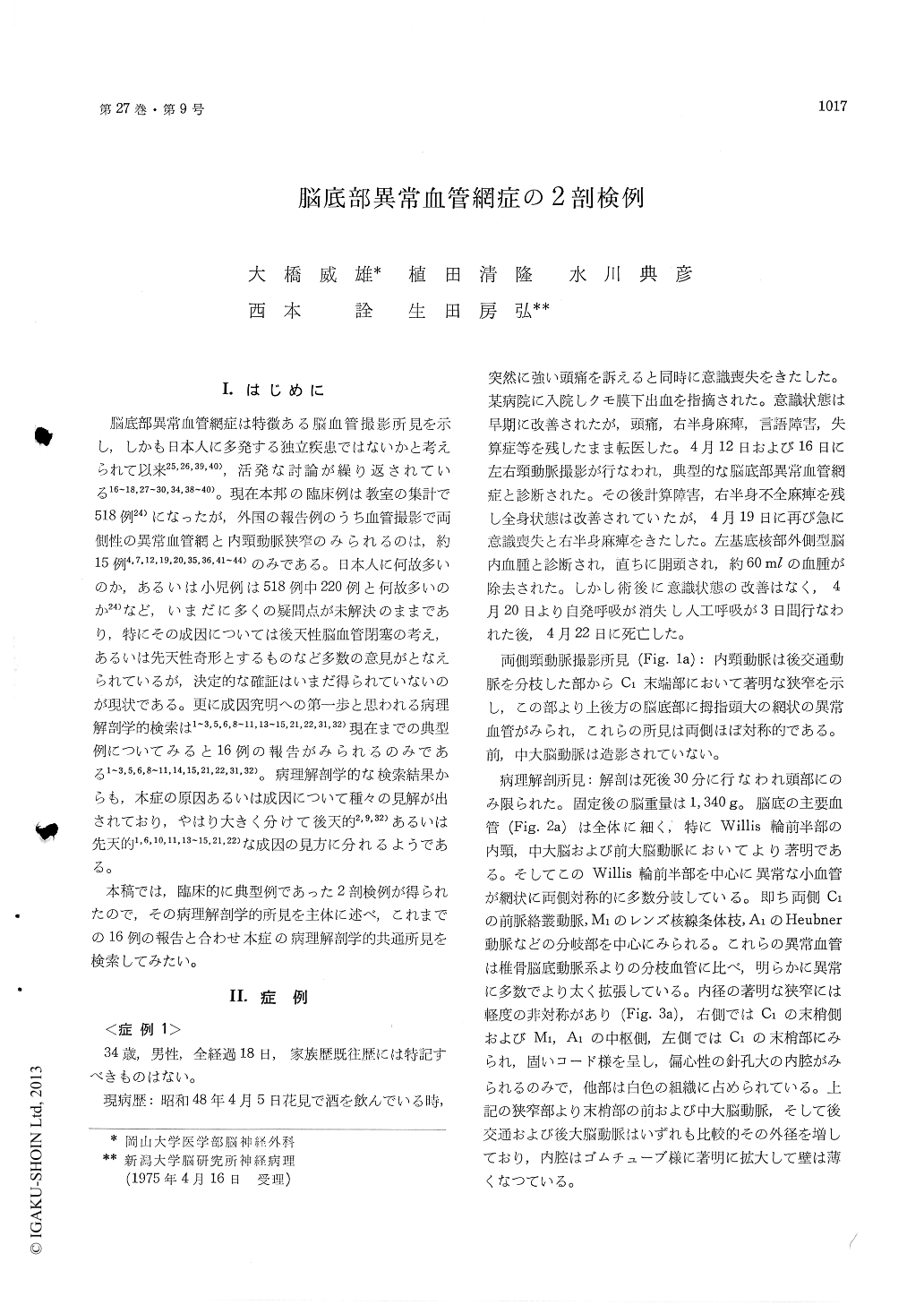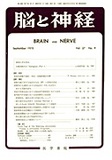Japanese
English
- 有料閲覧
- Abstract 文献概要
- 1ページ目 Look Inside
I.はじめに
脳底部異常血管網症は特徴ある脳血管撮影所見を示し,しかも日本人に多発する独立疾患ではないかと考えられて以来25,26,39,40),活発な討論が繰り返されている16〜18,27〜30,34,38〜40)。現在本邦の臨床例は教室の集計で518例24)になったが,外国の報告例のうち血管撮影で両側性の異常血管網と内頸動脈狭窄のみられるのは,約15例4,7,12,19,20,35,36,41〜44)のみである。日本人に何故多いのか,あるいは小児例は518例中220例と何故多いのか24)など,いまだに多くの疑問点が未解決のままであり,特にその成因については後天性脳血管閉塞の考え,あるいは先天性奇形とするものなど多数の意見がとなえられているが,決定的な確証はいまだ得られていないのが現状である。更に成因究明への第一歩と思われる病理解剖学的検索は1〜3,5,6,8〜11,13〜15,21,22,31,32)現在までの典型例についてみると16例の報告がみられるのみである1〜3,5,6,8〜11,14,15,21,22,31,32)。病理解剖学的な検索結果からも,本症の原因あるいは成因について種々の見解が出されており,やはり大きく分けて後天的2,9,32)あるいは先天的1,6,10,11,13〜15,21,22)な成因の見方に分れるようである。
本稿では,臨床的に典型例であった2剖検例が得られたので,その病理解剖学的所見を主体に述べ,これまでの16例の報告と合わせ本症の病理解剖学的共通所見を検索してみたい。
Japanese moyamoya disease is characterized inthe angiographic findings by bilateral stenoses ofthe distal portion of the carotid siphon and an ab-normal rete-like vessel in the base of the brain.This vascular disease is more frequent in theJapanese children and adolescents than in those ofother countries. However the etiology or patho-genesis of this disease is still unknown.
In this report pathological findings of two autopsycases demonstrating bilateral characteristicsof the carotid angiography are presented. A 34-year-old man had a sudden attack of severe headacheand loss of conciousness 18 days prior to death.Subarachnoid hemorrhage and right hemiplegiawere attributed to this case. After a transient im-provement, the man became unconscious again andthe craniotomy was performed for the intracerebralhematoma of the left lateral type. He expired on thethird day after operation. The second case was a42-year-old man who had an 8-year-long course ofillness. After transient speech disturbance, the mansuffered again from speech as well as visual dis-turbances for 6 years. Craniotomy was performedfor adhesive arachnoiditis of the optic chiasm 18months prior to his death by pneumonia.
On the findings in our cases and in other 16 typicalcases reported in Japan, main pathological findingsof the disease show:
1) Stenotic lesions of two types; older stenoseswere eccentric, dense and fibrous thickening of theintima at the distal portion of the both internalcarotid arteries. They were combined with slightsplitting of the internal elastic lamina and thinningof the tunica media, especially at the same site asthe thickened intima. Another stenotic lesions ap-peared as concentric, loose and fibrocellular thicken-ing of the intima. The thickening was combinedwith marked waving of internal elastic lamina andthinning of the tunica media in the circumferenceat the peripheral portin of the anterior and middlecerebral arteries. The latter type of stenoses weremore recent, probable secondary changes to the des-cibed ones. Histologically these two types ofstenotic lesions were distinguishable from athero-sclerosis.
2) Abnormal rete-like vessles ramified bilaterallyfrom anterior half of the circle of Willis, proximalpart of anterior and middle cerebral arteries as wellas periphery from old stenotic lesions at the distalportion of the internal carotid artery. The abnormalvessels constituted of leptomeningeal vessles ofabout 200 micron in caliber. It was difficult todistinguish if the vessels were arteries or veins.Histologically they were similar to arterio-venousmalformations.
3) The major arteries of the base of brain, in-cluding the vertebro-basilar system, revealed slendercaliber and hypoplastic appearance of the vascularwall, especially of tunica media. Some of themshowed anomalies, e. g. duplication of anteriorcomminucating artery and complete defect of tunicamedia of the basilar artery.
4) So called rete mirabile is found usually asincreasing networks of leptomeningeal vessels onthe cerebral convexity.
5) Secondary lesions, cerebral hemorrhages, in-farcts and/or atrophy, were commonly seen inthe autopsy cases.

Copyright © 1975, Igaku-Shoin Ltd. All rights reserved.


